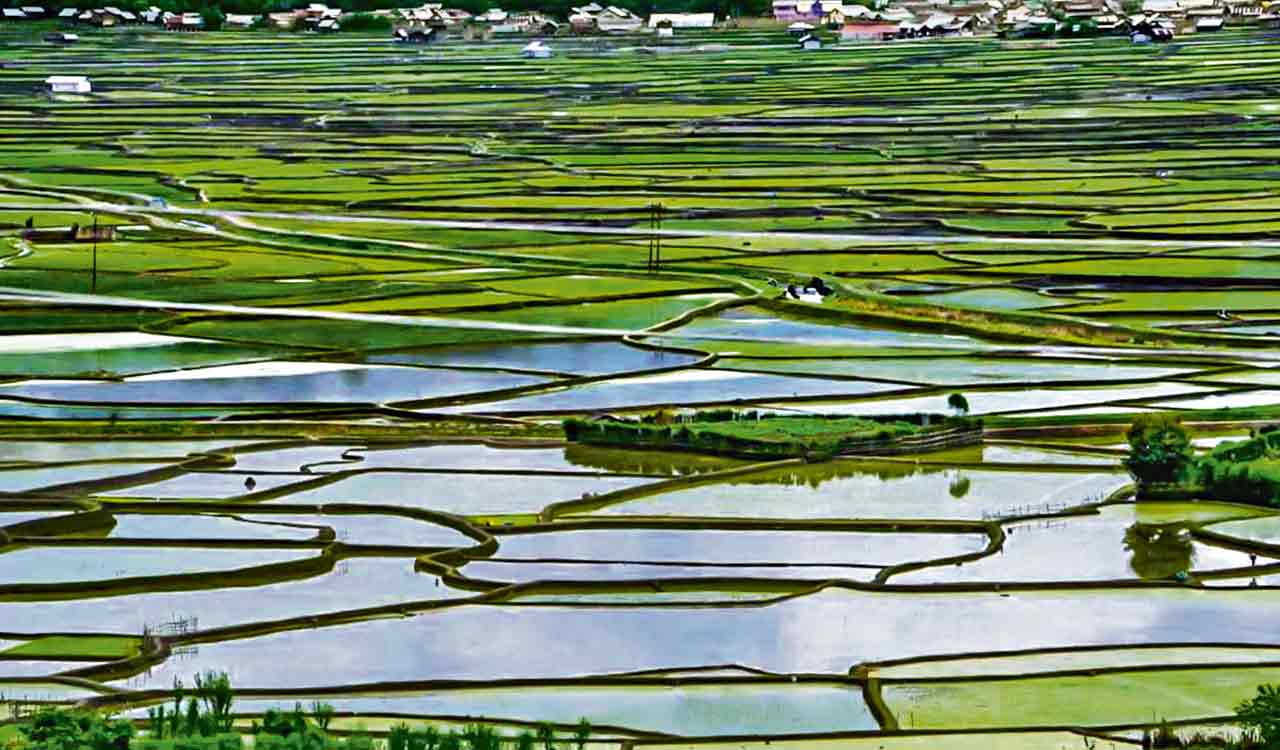Investment in technology must be prioritised and barriers to adoption must be addressed through essential government interventions.
Published Date – 9 April 2024, 11:50 PM

-By Sucheda Sardar, Amarnath Tripathi
In the wake of the ongoing farmer protests, the spotlight has once again turned to the deep-rooted challenges faced by agricultural communities across India. Amid demands for fair prices, agricultural reform and better livelihoods, the need for sustainable solutions to address these issues has become increasingly urgent.
Agriculture is facing a dual challenge: the impacts of climate change and rising greenhouse gas emissions from the sector. This underscores the urgency of developing climate-resilient agricultural practices. However, these challenges also exacerbate threats to food security and farmers’ incomes.
A recent estimate suggests that transitioning from the traditional rice-wheat farming system to alternative systems in Haryana and Punjab could potentially reduce farmers’ income by Rs 35,000 per hectare. Concurrently, the expansion of paddy cultivation in these regions has led to a decline in the water table and escalated air pollution due to paddy residue burning, highlighting the necessity of diversifying cropping patterns.
Here, the pressing question emerges: which alternative crop should take precedence? Given the aforementioned challenges, the selection of an alternative crop should be guided by the following criteria: Firstly, the chosen crop should align with consumption preferences and possess nutritional value, ensuring that consumer interests and nutrition security remain uncompromised.
Secondly, the crop should have market value, safeguarding farmers’ income. Thirdly, a vital consideration is the availability of a wide range of high-quality and hybrid seeds for the chosen crop. This will help prevent challenges to food production and supply. The Case for Maize Maize, a staple food for millions of economically disadvantaged individuals in India, meets all these criteria.
Globally recognized as the ‘queen of cereals’ owing to its exceptional genetic yield, maize is an affordable and nutritious dietary option. Despite India’s substantial maize production, it lags behind coun- tries like the US, China, Brazil and Mexico due to relatively low productivity.
Maize demonstrates remarkable adaptability and resilience to climate change challenges, thriving across diverse soil types and climatic conditions. Often grown in rotation with other crops, it promotes diversification and intercropping with rice, wheat, potatoes, chickpeas, cotton, mustard and more.
As a photo-insensitive C4 plant, maize requires significantly less water — approximately three times less — than other crops, making it suitable for drought conditions, high temperatures and limited carbon dioxide availability. This characteristic not only ensures its survival but also leads to substantial water and energy savings — up to 90% of water and 70% of power — compared to paddy cultivation.
Moreover, every component of the plant holds economic value and utility. Grains, leaves, stalks, tassels, cobs and more find utilisation in various food and non-food by-products. Maize serves diverse purposes, including human consumption and high-quality animal feed for poultry and livestock.
Additionally, it serves as a raw material for various industrial products such as starch, oil, protein, alcoholic beverages, pharmaceuticals, the paper industry and biofuels. India boasts the world’s largest live- stock population, with its feed industry witnessing a steady growth rate of 9% CAGR (compound annual growth rate). As consumption of eggs and poultry meat rises — experiencing CAGR rates of 6% and 9%, respectively — maize demand remains robust.
Over the past five years, maize consumption has demonstrated an impressive growth rate of 11% CAGR. However, India’s performance still significantly lags behind the global average, with a disparity of roughly 130%. The 9th Maize Summit, held in April 2023, emphasised the critical need to augment production by a minimum of 10 million tonnes, elevating it to 44-45 million tonnes within five years.
This stark gap underscores the necessity for intensified efforts to enhance productivity through innovative technologies and hybridisation.
In recent years, notable improvements in production have emerged due to the adoption of advanced technology and high-yield hybrid seeds.
However, adoption remains uneven, with only a few farmers across different States embracing hybrid seeds. Yields nearly doubled during the kharif season, con- tributing to approximately two-thirds during the rabi season.
The synergistic application of high-yield varieties alongside expanded crop areas has propelled robust production growth. Hybrid Tech Adoption Despite the productivity advantages of hybrid seeds, there are several concerns about the suitability of biological technology, particularly in the Indian setting where more than 86% of farmers own less than two hectares.
As long as these reservations persist and the benefits of the technology are not perceived, the adoption of the technology will either be sluggish or non-existent. Our recent research was conducted involving smallholder maize farmers from Uttar Pradesh and Bihar, two of the most underdeveloped States.
The study encompassed 648 samples from both States and was published in the journal titled ‘Technological Forecasting and Social Change’ in early 2023. The study aimed to analyse income and food security disparities between those who embraced hybrid technology and those who did not.
The findings re- vealed distinct advantages for small- holder farmers who integrated biological technology and hybrid seeds into their practices, as adopting farmers demonstrated higher levels of food security and income compared to their non-adopting counterparts. The adoption of hybrid technology yielded numerous direct and indirect positive outcomes.
Firstly, it significantly amplified crop yield, augmenting the volume of food available for personal consumption. Secondly, the heightened yield generated surplus marketable produce, thereby enhancing household income and intensifying overall crop production.
Lastly, improven household income empowered families to access additional nutritional resources, thereby enhancing overall nutritional status.
Global studies spanning countries such as the Philippines, China, Nigeria, Ghana, South Africa, Argentina and Pakistan echo similar findings, emphasising the positive impacts of adopting hybrid technology.
Given the consistent demand for maize across various sectors, there is promising potential to enhance both food consumption and income for marginalised farmers. However, realising these benefits requires substantial sup- port.
Investment in technology must be prioritised and barriers to adoption must be addressed through essential government interventions.
Crucial aspects include providing farmers with access to information about improved technologies, ensuring the timely availability of these technologies and complementary inputs, efficient management of supply chains, disseminating knowledge about climate change and facilitating easy access to credit, particularly for resource-scarce smallholder farmers.
With these elements in place, substantial investments in maize yield and strong collaboration between the industry and farmers can significantly expedite progress toward achieving these goals.
In conclusion, enhancing agricultural resilience and food security through maize diversification holds the promise of transforming India’s farming landscape.
By aligning crop choices with consumption preferences, leveraging market value and ensuring access to quality seeds and technology, maize can play a pivotal role in mitigating climate challenges and improving farmers’ livelihoods.
With coordinated efforts from policymakers, agricultural experts and local communities, India can unlock the full potential of maize, fostering sustainable growth and prosperity for its agricultural sector.

Capture




